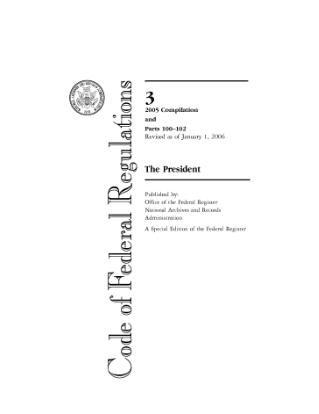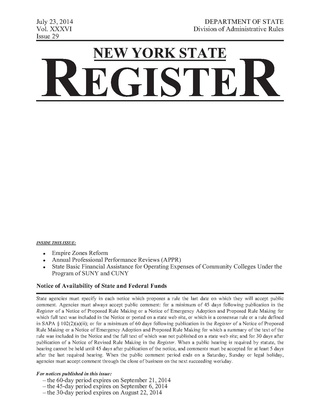A Notice of Proposed Rulemaking (NPRM) is a public notice that is issued by law when a U.S. federal agency wishes to add, remove, or change a rule or regulation as part of the rulemaking process. The notice is an important part of US administrative law, which facilitates government by typically creating a process of taking of public comment. The term is also used at the state level in the United States.

In the law of the United States, the Code of Federal Regulations (CFR) is the codification of the general and permanent regulations promulgated by the executive departments and agencies of the federal government of the United States. The CFR is divided into 50 titles that represent broad areas subject to federal regulation.

The Federal Register is the official journal of the federal government of the United States that contains government agency rules, proposed rules, and public notices. It is published every weekday, except on federal holidays. The final rules promulgated by a federal agency and published in the Federal Register are ultimately reorganized by topic or subject matter and codified in the Code of Federal Regulations (CFR), which is updated quarterly.
In administrative law, rulemaking is the process that executive and independent agencies use to create, or promulgate, regulations. In general, legislatures first set broad policy mandates by passing statutes, then agencies create more detailed regulations through rulemaking.
Vermont Yankee Nuclear Power Corp. v. Natural Resources Defense Council, 435 U.S. 519 (1978), is a case in which the United States Supreme Court held that a court cannot impose rulemaking procedures on a federal government agency. The federal Administrative Procedure Act of 1946 and an agency's statutory mandate from Congress establish the maximum requirements for an agency's rulemaking process. An agency may grant additional procedural rights in the regulatory process. However, a reviewing court cannot "impose upon the agency its own notion of which procedures are 'best' or most likely to further some vague, undefined public good"; to do so would exceed the limits of judicial review of agency action.
United States federal administrative law encompasses statutes, regulations, rules, common law rulings, and directives issued by the Office of Information and Regulatory Affairs in the Executive Office of the President, that together define the extent of powers and responsibilities held by administrative agencies of the United States government. The executive, legislative, and judicial branches of the U.S. federal government cannot always directly perform their constitutional responsibilities. Specialized powers are therefore delegated to an agency, board, or commission. These administrative governmental bodies oversee and monitor activities in complex areas, such as commercial aviation, medical device manufacturing, and securities markets.
A regulatory agency or independent agency is a government authority that is responsible for exercising autonomous dominion over some area of human activity in a licensing and regulating capacity.
The Administrative Law, Process and Procedure Project is a bipartisan undertaking of the Committee on the Judiciary of the House of Representatives of the United States Congress. It consists of a comprehensive study of the state of administrative law, process and procedure in the United States. A description of the Project was included in the Judiciary Committee's Oversight Plan for the 109th Congress, as approved by the Committee on January 26, 2005. The Project will culminate with the preparation of a detailed report with recommendations for legislative proposals and suggested areas for further research and analysis to be considered by the Administrative Conference of the United States (ACUS). House Judiciary Committee Chairman F. James Sensenbrenner, Jr. (R-WI) and Ranking Member John Conyers (D-MI) requested the Congressional Research Service (CRS) to assist Representative Chris Cannon (R-UT), the Chairman of the Subcommittee on Commercial and Administrative Law (CAL), in conducting the Project.

The Regulatory Flexibility Act (RFA) is perhaps the most comprehensive effort by the U.S. federal government to balance the social goals of federal regulations with the needs and capabilities of small businesses and other small entities in American society.

The law of California consists of several levels, including constitutional, statutory, and regulatory law, as well as case law. The California Codes form the general statutory law, and most state agency regulations are available in the California Code of Regulations.
The California Code of Regulations is the codification of the general and permanent rules and regulations announced in the California Regulatory Notice Register by California state agencies under authority from primary legislation in the California Codes. Such rules and regulations are reviewed, approved, and made available to the public by the Office of Administrative Law (OAL), and are also filed with the Secretary of State.
Midnight regulations are United States federal government regulations created by executive branch agencies during the transition period of an outgoing president's administration.
Title 1 of the Code of Federal Regulations, titled General Provisions, is a United States federal government regulation.

The Administrative Procedure Act (APA), Pub. L.Tooltip Public Law 79–404, 60 Stat. 237, enacted June 11, 1946, is the United States federal statute that governs the way in which administrative agencies of the federal government of the United States may propose and establish regulations, and it grants U.S. federal courts oversight over all agency actions. According to Hickman & Pierce, it is one of the most important pieces of United States administrative law, and serves as a sort of "constitution" for U.S. administrative law.

The California Office of Administrative Law (OAL) is the California agency responsible for carrying out the rulemaking part of the California Administrative Procedure Act. It is overseen by the California Government Operations Agency.

The California Administrative Procedure Act (APA) is a series of acts of the California Legislature first enacted 15 June 1945 that requires California state agencies to adopt regulations in accordance with its provisions. It predates the federal Administrative Procedure Act that was enacted almost a year later on 11 June 1946.
The New Jersey Administrative Code (N.J.A.C.) is the codification of all rules and regulations made by the executive branch agencies of New Jersey.
The law of New Jersey consists of several levels, including constitutional, statutory, regulatory, case law, and local law.

The New York State Register is the official journal of the New York state government that contains information on proposed regulations and rulemaking activities. The New York State Register is published weekly by the New York State Department of State's Division of Administrative Rules. The general and permanent regulations are compiled in the New York Codes, Rules and Regulations (NYCRR).
Executive Order 12866 in the United States, issued by President Clinton in 1993, requires a benefit-cost analysis for any new regulation that is "economically significant", which is defined as having "an annual effect on the economy of $100 million or more or adversely affect[ing] in a material way the economy, a sector of the economy, productivity, competition, [or] jobs," or creating an inconsistency with other law, or any of several other conditions. The Order established a "regulatory philosophy" and several "principles for regulation", among them requirements to explicitly identify the problem to be addressed, determine whether existing regulations created or contributed to the problem, assess alternatives to direct regulation, and design regulations in the most cost-effective manner possible. Section § 1(a) summarizes this regulatory philosophy as follows:
Federal agencies should promulgate only such regulations as are required by law, are necessary to interpret the law, or are made necessary by compelling public need, such as material failures of private markets to protect or improve the health and safety of the public, the environment, or the well-being of the American people.







